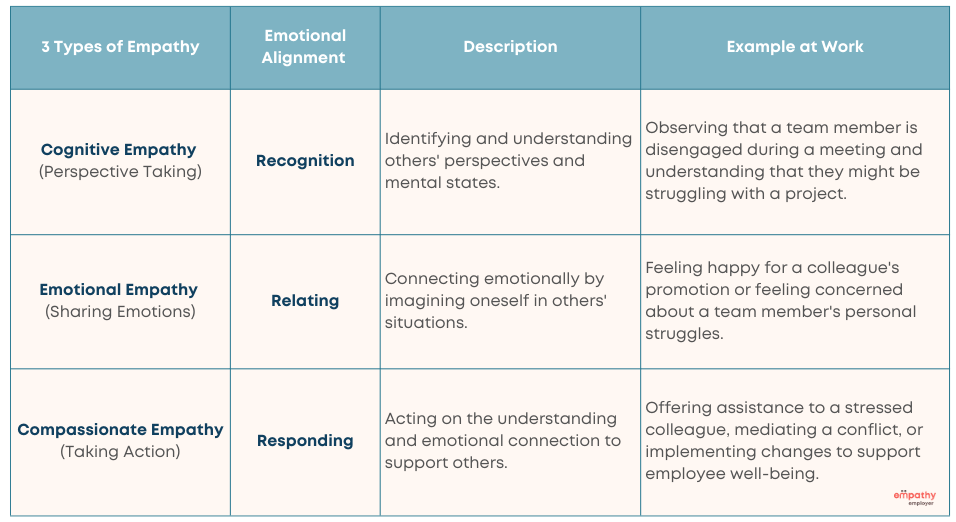What is empathy
Empathy is ability to recognize, relate, and respond to the individual perspectives, mental states, and feelings of others. To better understand empathy in our daily lives (and the workplace), we frame it as 3 types of empathy – Cognitive, Emotional, and Compassionate.
Different types of empathy
Let’s talk about the three (3) types of empathy along with workplace related examples:
Cognitive Empathy (Perspective Taking)
This is the ability to understand another person’s thoughts and feelings without necessarily experiencing them yourself. Imagine it like mentally stepping into their shoes. In the workplace, cognitive empathy might look like:
- Understanding a client’s frustration with a complex product
- Figuring out why a colleague seems disengaged during a meeting
- Seeing a situation from a manager’s perspective
Emotional Empathy (Sharing Emotions)
This is the ability to resonate with the emotions of others. It’s about acknowledging and understanding their feelings, but not becoming overwhelmed by them yourself. Imagine feeling a twinge of disappointment alongside a colleague who lost a sale, but without getting discouraged yourself. In the workplace, emotional empathy involve:
- Feeling a sense of urgency when a teammate is facing a tight deadline
- Sharing in the excitement of a colleague who gets a promotion
- Recognizing a customer’s anger or frustration
Compassionate Empathy (Taking Action)
This is the combination of cognitive and emotional empathy, but with the added element of taking action to help. It’s about being motivated to support someone based on your understanding and shared emotions. This doesn’t mean fixing their problems, but offering resources, taking appropriate action, or simply being a listening ear. In the workplace, compassionate empathy could involve:
- Offering to help a colleague brainstorm solutions after a setback
- Advocating for a client who feels unheard
- Providing emotional support to a teammate going through a difficult time
What is the difference between Empathy and Sympathy
When distinguishing empathy from sympathy, it’s essential to realize that they involve different depths of understanding and connection. Sympathy often stops at acknowledging someone else’s feelings, usually accompanied by a sense of pity or sorrow. It’s more about expressing concern from an external perspective, often without deeper engagement.
Empathy, on the other hand, dives further. It requires putting yourself in someone else’s shoes. This process involves actively listening to their experiences, acknowledging their emotions, and responding with genuine warmth and understanding.
Instead of merely feeling sorry, empathy encourages you to validate and resonate with the other person’s feelings, showing that you truly grasp their emotional state. This approach fosters a stronger emotional bond and encourages authentic interaction.
In short, while both empathy and sympathy involve relating to others’ emotions, empathy prioritizes connection and understanding over surface-level concern.
- Recognition: We can identify the emotions, thoughts, and experiences of others. This might involve observing their body language, listening to their tone of voice, or understanding the context of a situation.
- Relating: We can connect with those emotions and understand how they might feel in that situation. Here, we put ourselves in their shoes mentally and imagine their perspective.
- Responding: Based on our understanding, we can adjust our behavior or communication accordingly. This could involve offering support, expressing concern, or simply being a good listener.

Empathy is the cornerstone of strong working relationships. It allows us to connect with colleagues, build trust, and foster a positive work environment. But what is empathy and how does it relate to our daily lives?
We define empathy as the ability to recognize, relate, and respond to the individual perspectives, mental states, and feelings of others. Our definition highlights the three key practical stages of empathy:
Empathy definition and practical application
How to better understand empathy

Can you learn empathy
Yes, empathy is a skill that can be learned and improved with practice. By developing and practicing all three types of empathy, you can become a more effective communicator, collaborator, and leader. You’ll build stronger relationships, create a more positive work environment, and foster a sense of connection within your team. Moreover, you may also observe empathy improving your organization’s business performance as well.




Employees feel valued and heard
Open communication and mutual respect creates a supportive environment
Diverse ideas spark innovation
Teams explore a wider range of solutions, leading to creative and groundbreaking ideas
Attract and retain top talent
Strong company culture built on empathy attracts the best and brightest who stay with the organization
Empathy in the workplace
A supportive, trusting, and inclusive environment where employees feel valued and understood enhances the employee experience. This sense of connection allows them to freely share ideas, collaborate effectively, explore a wider range of solutions, leading to more creative problem-solving and groundbreaking innovations. Organizational cultures that embrace these empathic values attract and retain top talent.
Why authenticity matters in empathy
Empathy isn’t just about stepping into someone else’s shoes; it’s about genuinely connecting on a human level. Authenticity is crucial in this process for several reasons.
- True connection: When you authentically engage with someone’s experience, you build a real connection. This sincerity provides comfort and understanding for the person you’re supporting, allowing them to feel truly heard and valued.
- Balanced emotional engagement: Being authentic helps maintain a balanced perspective. When we are genuine, we navigate our emotions more effectively, ensuring we are present without overwhelming ourselves. This balance keeps empathy productive and meaningful.
- Enhancing trust: Authentic empathy fosters trust. People can sense when your concern is genuine, and this trust becomes the foundation for stronger relationships. Without authenticity, interactions can feel hollow, leading to disconnection.
- Fulfilling the human experience: Engaging authentically with others enriches our own lives. It allows us to explore the diversity of human emotions and experiences, making our understanding of the world more comprehensive and profound.
Understanding these aspects reveals why authenticity in empathy isn’t just beneficial—it’s essential. By being genuine, you not only support others more effectively but also enhance your own emotional intelligence and well-being.
How does empathy relate to emotional intelligence
Empathy is a fundamental skill that enhances both personal and professional relationships. It’s an essential component of emotional intelligence (EQ), which encompasses the ability to comprehend and manage not only your emotions but also those of others. Let’s delve into how empathy uniquely contributes to emotional intelligence.
- The role of empathy in emotional intelligence: Empathy provides the foundation for emotional intelligence, acting as a bridge to better communication and deeper connections with others. It allows individuals to recognize and respond to the emotions of colleagues, friends, and family, thereby fostering a supportive environment.
- Enhancing emotional intelligence through empathy: Empathy enriches emotional intelligence by encouraging openness and sensitivity in interactions. When you practice empathy: You sharpen your social skills, making it easier to navigate complex social situations. It becomes simpler to manage your own emotions, as understanding others’ feelings gives perspective. Decision-making improves because it integrates a balanced view of emotional and logical considerations.
What are the benefits and pitfalls of cognitive empathy
Cognitive empathy is a fascinating concept, often referred to as “perspective-taking.” It’s about mentally grasping how someone else might feel or think. However, like any skill or trait, it comes with its own set of advantages and disadvantages.
Pitfalls of cognitive empathy
Emotional disconnection: Relying heavily on cognitive empathy can lead to disregarding emotional nuances, making interactions feel cold or impersonal.
Limited emotional insight: Unlike emotional empathy, cognitive empathy doesn’t involve sharing another’s feelings, which can sometimes lead to a lack of deep emotional connection.
Misinterpretations: Without the ability to feel what others feel, there’s a risk of misunderstanding the depth and nuance of their emotions.
Detached problem-solving: While useful, a purely logical approach in emotionally charged situations can seem insensitive, as it may not acknowledge the emotional weight individuals are carrying.
Leadership challenges: Leaders who lean too much on cognitive empathy might struggle to nurture emotional bonds, essential for team cohesion and morale.
Benefits of cognitive empathy
Enhanced negotiations: By understanding the thoughts and motivations of others, one can approach negotiations more strategically, often leading to more favorable outcomes for all parties involved.
Logical decision-making: Particularly useful in situations that demand rational thinking, cognitive empathy allows individuals to set aside emotions and focus on clear, objective reasoning.
Motivational leadership: Leaders who apply cognitive empathy can better inspire their teams by acknowledging and exploring differing viewpoints, which encourages a broader range of ideas and solutions.
Diversity appreciation: It helps in recognizing and valuing diverse perspectives, fostering a more inclusive environment where varied thoughts are understood and respected.
Effective in virtual contexts: In settings like virtual meetings where body language cues are limited, cognitive empathy helps bridge the gap by focusing on verbal and written communication.
In essence, cognitive empathy is a powerful tool, especially in analytical or professional settings. However, balancing it with emotional empathy is crucial to ensure interactions are both understanding and genuinely compassionate.
What are the benefits and pitfalls of emotional empathy
Emotional empathy is a powerful tool that aids in building strong, intimate relationships. Emotional empathy involves sincerely feeling another person’s emotions. It’s often associated with being an “empath,” someone who can deeply and genuinely experience the emotional and mental state of others.
This ability is more than just a sentimental inclination, it’s rooted in the brain’s function. Mirror neurons, present in both humans and animals, fire when we observe others, allowing us to relate to their emotions and actions intuitively.
For instance, when someone we care about is upset, our natural response is often to empathize deeply, creating a bond that can be both rewarding and intense. However, the challenge lies in managing this empathetic response to avoid being overwhelmed.
Pitfalls of emotional empathy
- Emotional overload: There’s a risk of emotional contagion, where one can unintentionally absorb and be overwhelmed by another’s emotions.
- Inappropriate emotional reactions: In certain contexts, sharing emotions might be unsuitable, leading to misunderstandings or discomfort.
- Psychological exhaustion: When individuals cannot regulate their emotions, empathy can become a burden, potentially leading to emotional burnout.
Benefits of emotional empathy
- Form close bonds: Through genuine emotional connections, it fosters deep interpersonal relationships.
- Parent effectively: By understanding and sharing a child’s feelings, it strengthens the parent-child bond.
- Excel in empathy-driven professions: Professions such as nursing, coaching, marketing, and human resources see significant benefits as empathy facilitates better communication and understanding.
- Promote understanding: Motivates an effort to deeply understand others, encouraging a supportive environment.
- Connect deeply: Emotional empathy nurtures a sense of connection, allowing for more profound interpersonal engagement.
What are the benefits and pitfalls of compassionate empathy
Compassionate empathy is a powerful tool in human interactions, offering profound benefits. While compassionate empathy is generally seen as a virtue, there are considerations to bear in mind, including:
Pitfalls of compassionate empathy
- Emotional exhaustion: Continuously engaging in compassionate empathy without boundaries can lead to burnout. It is essential to manage one’s emotional resources effectively to maintain sustained engagement and care.
Benefits of compassionate empathy
Holistic understanding: Compassionate empathy allows us to see the complete picture, taking into account the complex experiences that shape a person’s actions and emotions. By doing so, we engage with them more deeply and genuinely.
Inspiration to act: Unlike other forms of empathy that might only involve understanding or sharing feelings, compassionate empathy motivates us to help, fostering a proactive approach to both personal and societal issues.
Enhanced global perspective: Embracing compassionate empathy encourages us to extend our compassion beyond immediate circles, allowing us to engage empathetically with global events and challenges. This can lead to more informed and compassionate responses to worldwide issues.
As discussed above, the pitfalls manageable and benefits of compassionate empathy underscore its role as a fundamental aspect of our humanity, pushing us to become more connected and altruistic individuals.
Can someone have too much empathy?
When we talk about empathy, we often view it as a virtue or a powerful tool for connecting with others. However, one might wonder: is it possible to have too much empathy? The short answer is yes. Sometimes, overwhelming empathy can lead to emotional burnout and weaken personal boundaries.
Empathy overload: the risks
- Emotional drain: Constantly absorbing the emotions of others without setting boundaries may leave you feeling drained or overwhelmed. It’s crucial to remember that while empathy allows us to understand others, maintaining your emotional well-being should also remain a priority.
- Blurred boundaries: With too much empathy, it becomes easy to blur the lines between your feelings and those of others. This might lead to losing a sense of self, as you might prioritize others’ emotions over your own needs and values.
- Decision paralysis: High levels of empathy might cause difficulty in making decisions. You could find yourself caught in a loop of overthinking how choices will affect everyone around you, rather than focusing on what is best for the situation at hand.
Balancing empathy
Set clear boundaries: Establish and communicate personal boundaries. Recognizing when to step back protects you from feeling overwhelmed and ensures balanced relationships.
Practice self-care: Engage in activities that replenish your emotional reserves. Whether it’s through hobbies, meditation, or physical exercise, taking time for self-care is essential.
Empathy in moderation: Approach empathy with a mindset of moderation. Selectively choose when to deeply engage and when to safeguard yourself from over-absorption of others’ emotional states.
Empathy is like any other trait—it requires balance. By understanding its potential downsides and learning to manage them, you can wield empathy as an effective tool while maintaining your well-being.
Learning resources for improving empathy skills
Check out these curated list of self-paced online learning courses to enhance your empathy skills. Most of these are free or offer a low-cost participation option.

